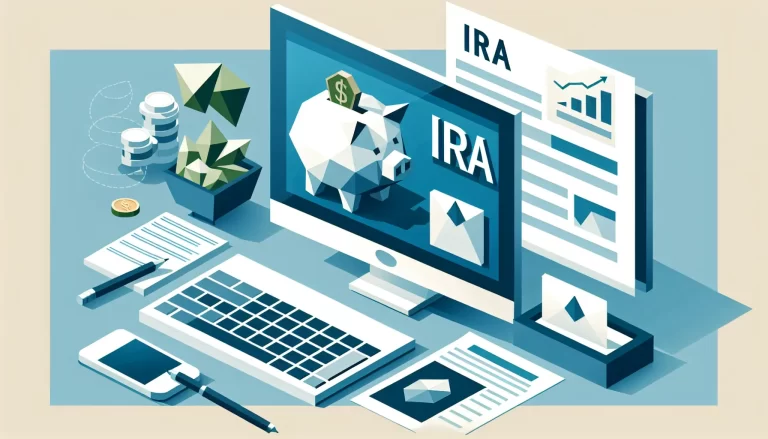Having made your decision to take one step closer to setting up a precious metals IRA, in this article we are going to cover everything from the basics of a standard IRA, how it differs from a precious metals IRA, and how to set up a Gold IRA for instance.
I have included links to articles throughout the content on other types of Precious Metal IRAs; like Gold, Silver, and Palladium to name a few.
Expect to spend 12 minutes reading this article.
If you would like more information on those, please open them in a new tab so you can make your most informed decision.
Setting up an IRA can be a great way to secure your financial future. In this article, we’ll help you understand the basics of IRAs and guide you in choosing the right one for your needs.
Quick Disclaimer:
The content provided in this article is for informational purposes only and should not be considered financial or investment advice. Always consult with a qualified financial advisor before making any decisions regarding Precious Metal IRAs. Additionally, this article contains affiliate links, and I may earn a commission if you make a purchase through these links, at no additional cost to you.
Another question, I have been asked is, “What Gold IRA companies are the best” or “Which IRA companies are the most trusted?”.
If you’d like more information, below is a link to a comparison PDF by Augusta Precious Metals that could be useful. (It’s also free.)
Augusta Gold IRA Company Integrity Checklist
Understanding IRA Basics
An Individual Retirement Arrangement (IRA) is a tax-favored personal savings plan that allows you to set aside money for retirement.
You can establish an IRA with a bank, insurance company, or other financial institution (IRS).
IRAs provide a way to make tax-deferred investments, which means you can invest without paying taxes on the earnings until you withdraw the money (IRS).
Here are the key features of an IRA:
- Tax Benefits: Contributions to an IRA can be tax-deductible, and the investments grow tax-deferred until withdrawal.
- Contribution Limits: For 2023, you can contribute up to $6,000 per year, or $7,000 if you are age 50 or older (IRA contribution limits).
- Eligibility: Anyone with earned income can contribute to an IRA, regardless of age, thanks to the SECURE ACT of 2019 (Investopedia).
To learn more about the basics of IRAs, visit our detailed guide on IRA account types.
Choosing the Right IRA
Selecting the right IRA involves considering your age, income, and financial goals. There are several types of IRAs, each with its own rules and tax advantages. The most common types are Traditional IRAs and Roth IRAs.
Traditional IRAs
A Traditional IRA allows you to make contributions that may be tax-deductible. The investments grow tax-deferred, and you pay taxes on the money when you withdraw it in retirement. This type of IRA is suitable if you expect to be in a lower tax bracket when you retire.
Key points:
- Tax Deduction: Contributions may be tax-deductible.
- Tax-Deferred Growth: Earnings grow tax-deferred until withdrawal.
- Required Minimum Distributions (RMDs): You must start taking distributions at age 72.
Roth IRAs
A Roth IRA is funded with after-tax dollars, meaning contributions are not tax-deductible. However, the investments grow tax-free, and qualified withdrawals are also tax-free. This type is ideal if you expect to be in a higher tax bracket in retirement.
Key points:
- No Tax Deduction: Contributions are made with after-tax money.
- Tax-Free Growth: Earnings grow tax-free.
- No RMDs: No required minimum distributions during the account holder’s lifetime.
| Feature | Traditional IRA | Roth IRA |
|---|---|---|
| Tax Deduction | Yes | No |
| Tax-Deferred Growth | Yes | No |
| Tax-Free Withdrawals | No | Yes |
| RMDs | Yes (Age 72) | No |
Choosing between a Traditional and Roth IRA depends on your current and expected future tax situation. For more on selecting the right IRA, visit IRA account types.
For those interested in investing in precious metals, consider a precious metals IRA to diversify your portfolio. Learn about the benefits and steps to open such accounts by exploring our resources on precious metals investing.

Another common question I get asked about sales tactics used by Gold IRA companies is about how silver is leveraged and mentioned.
If you want to learn more, below are two free PDFs by Augusta Precious Metals that break down how to check the integrity of an IRA provider as well as information on how Silver is used as a sales tactic.
Augusta Precious Metals Links:
Types of IRAs
Understanding the different types of IRAs is essential when considering precious metals investments.
The two main types are Traditional IRAs and Roth IRAs – and of course Precious Metals IRAs, which is what we primarily cover on this website.
Traditional IRAs
A Traditional IRA is a long-term, tax-advantaged savings account designed for individuals with earned income. Contributions to a Traditional IRA may be tax-deductible, which means they reduce your taxable income for the year. However, taxes are deferred until you withdraw the funds during retirement.
Key Features:
- Tax Deductibility: Contributions may be tax-deductible.
- Taxation: Withdrawals in retirement are taxed as ordinary income.
- Required Minimum Distributions (RMDs): You must start taking RMDs at age 72.
- Contribution Limits: Contributions limits are set annually; visit IRA contribution limits for the most current information.
- Beneficiaries: Cannot be owned jointly; upon death, remaining amounts are paid to designated beneficiaries.
Roth IRAs
A Roth IRA is another type of individual retirement account, but with different tax implications.
Contributions to a Roth IRA are made with after-tax dollars, meaning they are not tax-deductible in the year of contribution. However, qualified distributions are tax-free, providing a significant benefit during retirement.
Key Features:
- Tax Deductibility: Contributions are not tax-deductible.
- Taxation: Qualified withdrawals are tax-free (Investopedia).
- Required Minimum Distributions (RMDs): No RMDs during the account holder’s lifetime.
- Contribution Limits: Contribution limits are set annually; visit IRA contribution limits for updated information.
- Age Limit: Starting from 2020, there is no age limit on making regular contributions.
| Feature | Traditional IRA | Roth IRA |
|---|---|---|
| Tax Deductibility | Yes | No |
| Taxation on Withdrawals | Yes | No |
| RMDs | Yes, at age 72 | No |
| Age Limit for Contributions | No | No |
| Contribution Limits | Yes | Yes |
For those interested in investing in precious metals like gold or silver, both Traditional and Roth IRAs can be used.
Each type of IRA has unique benefits, so it’s important to consider your current tax situation and future retirement goals. For more information on setting up a precious metals IRA, explore our guide on precious metals IRAs.

Steps to Open an IRA
Opening an IRA is a straightforward process that involves gathering information, selecting an IRA provider, and completing the application. Let’s walk through the steps to get you started on your journey to precious metals investing.
Gathering Required Information
To set up your IRA, you will need to provide personal documentation to verify your identity. This typically includes:
- Social Security number
- Date of birth
- Contact information (address, phone number, email)
- Employment details (if applicable)
- Banking information for funding your account
Having these details ready will make the process smoother. For more information on what you need, check out IRA account eligibility.
Selecting an IRA Provider
Choosing the right IRA provider is crucial. You want to select an institution that has received IRS approval, such as banks, brokerages, federally insured credit unions, and savings and loan associations. Factors to consider when selecting a provider include:
- Fees: Look at IRA fees and compare across providers.
- Investment options: Ensure they offer precious metals investing if that’s your focus.
- Services: Evaluate their customer service and additional features.
Many IRA providers do not require a minimum amount to open an IRA account. This can be beneficial if you’re starting with a small initial investment.
Completing the Application
Once you’ve gathered your information and selected your provider, the next step is completing the application. This can typically be done online or in person. Here’s what to expect:
- Personal Details: Fill out your Social Security number, date of birth, and contact information.
- Verification: Provide personal documentation to verify your identity.
- Funding: You can transfer money directly from a bank using your bank account and routing numbers.
After completing these steps, your IRA will be set up, and you can begin investing in precious metals. To understand the different options available, explore our articles on gold IRA, silver IRA, and other IRA investment options.
| Step | Description |
|---|---|
| Gather Information | Collect personal and financial details |
| Select Provider | Choose an IRS-approved institution |
| Complete Application | Fill out required forms and verify identity |
For more details on funding your IRA, visit IRA contribution limits and IRA rollover.
Funding Your IRA
Getting your IRA funded is a critical step in your journey towards investing in precious metals. There are different methods to accomplish this, including direct contributions and rollovers or transfers. Understanding these options can help you make informed decisions and maximize the benefits of your IRA account setup.
Direct Contributions
Direct contributions are one of the simplest ways to fund your IRA. These are the personal deposits you make into your IRA account each year. It’s essential to know the ira contribution limits set by the IRS, which can change annually.
For 2023, the contribution limits for an IRA are as follows:
| Age | Contribution Limit |
|---|---|
| Under 50 | $6,000 |
| 50 and Over | $7,000 |
Making direct contributions allows you to regularly add funds to your IRA, thus growing your investment over time. For those interested in precious metals, this means you can incrementally buy assets like gold or silver, diversifying your ira investment options.
Rollovers and Transfers
Another effective way to fund your IRA is through rollovers and transfers. These methods involve moving funds from other retirement accounts, such as a 401(k) or another IRA, into your new IRA.
Rollovers
Rollovers entail transferring funds from one retirement account to another. This is often done when changing jobs or seeking better investment options. A popular choice for many is rolling over a 401(k) into an IRA. IRAs typically offer a wider array of investment choices and lower fees (NerdWallet). However, keep in mind that you can only make one rollover from an IRA to another in any one-year period (IRS).
Transfers
Trustee-to-trustee transfers are another way to move funds into your IRA. Unlike rollovers, there is no limit on the number of transfers you can make in a year. This method involves moving the money directly from one financial institution to another, without you taking possession of the funds. This is often the preferred method due to its simplicity and lack of IRS limitations.
For a smooth transfer or rollover, ensure you:
- Gather all required information from your current retirement account.
- Contact your new ira custodian and initiate the transfer.
- Follow up to ensure the transfer is completed without any issues.
Both rollovers and transfers can be used to fund a precious metals ira, allowing you to invest in assets like gold, silver, platinum, and palladium. For detailed steps on how to execute these transfers, refer to our guide on ira rollover.
By understanding these funding options, you can efficiently set up and grow your IRA, paving the way for a secure and diversified retirement portfolio.
Investment Options
When setting up your IRA, you have a couple of key options for how to invest. You can choose a simplified approach with all-in-one funds or customize your portfolio to suit your specific investment goals.
All-in-One Funds
All-in-one funds are a popular option for those who prefer a hands-off approach to investing. These funds simplify the investment process by pooling your money into a diversified portfolio managed by professionals. This can be especially appealing for newcomers to investing or those who don’t have the time to closely monitor their investments.
Advantages of All-in-One Funds
- Diversification: Your money is spread across a variety of assets, reducing risk.
- Professional Management: Experienced fund managers handle the investment choices.
- Convenience: Minimal effort is required on your part.
All-in-one funds can include target-date funds and balanced funds. Target-date funds automatically adjust the asset allocation as you approach your retirement date, becoming more conservative over time. Balanced funds maintain a fixed allocation between stocks and bonds.
For more information on the benefits and options, check out our article on IRA investment options.
Customizing Your Portfolio
If you prefer more control over your investments, customizing your portfolio might be the way to go. This option allows you to select individual assets, such as stocks, bonds, and precious metals, based on your risk tolerance and financial goals.
Steps to Customize Your Portfolio
- Assess Your Risk Tolerance: Determine how much risk you’re willing to take.
- Choose Your Investments: Select a mix of assets, balancing risk and potential return.
- Diversify: Spread your investments across different asset classes to mitigate risk.
Popular Asset Classes for Custom Portfolios
- Stocks: Ownership in companies, offering potential for growth.
- Bonds: Loans to governments or corporations, providing income through interest.
- Precious Metals: Investing in gold IRAs, silver IRAs, platinum IRAs, and palladium IRAs can provide a hedge against inflation and economic uncertainty.
| Asset Class | Risk Level | Potential Return |
|---|---|---|
| Stocks | High | High |
| Bonds | Low to Medium | Medium |
| Precious Metals | Medium | Medium to High |
For those interested in precious metals, it’s crucial to understand the specific requirements and benefits. Learn more about setting up a precious metals IRA and the associated precious metals IRA fees.
Whether you choose all-in-one funds or a customized portfolio, your investment strategy should align with your long-term financial goals. Consider consulting with a financial advisor to help you navigate your IRA account setup and make informed decisions. For additional insights, explore our articles on IRA account benefits and IRA tax advantages.
Important Considerations
When setting up your IRA for precious metals investing, it’s essential to consider several factors to ensure you make informed decisions. Here are some key aspects to keep in mind:
Fees and Services
Understanding the fees and services associated with your IRA is crucial. Different IRA providers may charge varying fees for account setup, annual maintenance, and storage, especially for precious metals IRAs. It’s important to compare these costs to find the best option for your needs.
| Fee Type | Typical Range |
|---|---|
| Account Setup Fee | $50 – $200 |
| Annual Maintenance | $75 – $300 |
| Storage Fee | $100 – $300 per year |
For more detailed information on fees, visit our page on IRA fees.
Tax Implications
Tax implications play a significant role in your IRA account setup. Contributions to a Roth IRA are not deductible and must be designated as a Roth IRA when the account is set up. Qualified distributions from a Roth IRA are not subject to tax (IRS). On the other hand, traditional IRAs offer tax-deductible contributions, but withdrawals are taxed as ordinary income.
It’s also important to note that excess IRA contributions are subject to a 6% tax per year if not withdrawn, calculated on the combined value of all IRAs at the end of the tax year (IRS). For more information on tax benefits, visit our page on IRA tax advantages.
Withdrawal Rules
Traditional IRAs require you to start taking required minimum distributions (RMDs) at age 72, whereas Roth IRAs do not have RMDs during the account owner’s lifetime.
You can only make one rollover from an IRA to another in any one-year period, but a trustee-to-trustee transfer does not count as a rollover (IRS). For more details on withdrawals and penalties, visit our page on IRA withdrawal.
By considering these important factors, you can make informed decisions and optimize your precious metals IRA. Explore our related resources on self-directed IRA, gold IRA, and IRA investment options for more insights.



